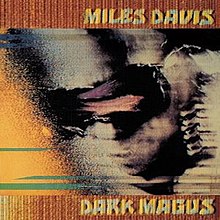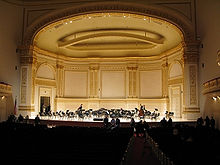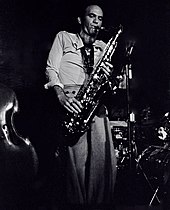Dark Magus
| Dark Magus | ||||
|---|---|---|---|---|
 | ||||
| Live album by | ||||
| Released | 1977 | |||
| Recorded | March 30, 1974 | |||
| Venue | Carnegie Hall New York City | |||
| Genre | ||||
| Length | 100:58 | |||
| Label | CBS/Sony | |||
| Producer | Teo Macero | |||
| Miles Davis chronology | ||||
| ||||
| Miles Davis live chronology | ||||
| ||||
Dark Magus is a live
Dark Magus was released after Davis' 1975 retirement, upon which
Despite an ambivalent reception by contemporary music critics, Dark Magus inspired
Background


The March 30, 1974, concert featured an ethnically and age-diverse audience that included young hippies and old, wealthy attendees. According to Magnet magazine's Bryan Bierman, "the hip, 'with it' kids [sat] side-by-side with middle-aged tuxedoed couples, expecting to hear 'My Funny Valentine.'"[1] Although he lived only 15 minutes away, Davis arrived at the venue more than an hour late. When the band walked out onstage, he followed with his back turned to the audience,[1] casually strolling onstage while the other musicians were setting up. Davis immediately began to play, and the band responded by playing a dense rhythm in unison.[3] Saxophonist Dave Liebman, writing in the 1997 US reissue liner notes for Dark Magus,[4] recalled the start of the show: "It is his whim .. That's the thing! ... Miles can do that and have three thousand musicians follow him. Right? So what I learned in that respect from Miles was to be able to watch him and be on his case."[3]
Somehow, he would get you to play in a manner that in most cases you would never do again.
—Liebman on Davis[5]
Davis used the show to audition two new members—tenor saxophonist Azar Lawrence and guitarist Dominique Gaumont.[3] Lawrence was a highly regarded young saxophonist at the time, while Gaumont was enlisted by Davis in response to incumbent guitarist Reggie Lucas's demand for a pay raise.[6] Although it was unexpected, Liebman later characterized the move as typical Davis: "What he was doing—which he often does at big kinda gigs like that—is change the shit up, by doing something totally out. Totally unexpected. I mean, we had been a band together on the road for a year ... And then, suddenly, a live date, New York City, Carnegie Hall, the cat pulls two cats who never even saw each other. I mean, you gotta say, 'Is the man mad or is he – he's either mad or extremely subtle."[3]
Composition and performance
[Davis] shifted gears at will in his early-'70s music, orchestrating moods and settings to subjugate the individual musical inspirations of his young close-enough-for-funk subgeniuses to the life of a single palpitating organism that would have perished without them—no arrangements, little composition, and not many solos either, although at any moment a player could find himself left to fly off on his own.
Dark Magus features four two-part compositions with an average length of 25 minutes each.
Throughout the work, Davis soloed only intermittently or played his Yamaha
According to
Release
Dark Magus was released after Davis' retirement, when
The album was not released in the United States until July 1997, when it was
Reception and legacy
| Review scores | |
|---|---|
| Source | Rating |
Encyclopedia of Popular Music | |
| Entertainment Weekly | A[18] |
| Los Angeles Times | |
| MusicHound Jazz | 3.5/5[20] |
| The Penguin Guide to Jazz | |
| Pitchfork | 9.5/10[22] |
| The Rolling Stone Album Guide | |
Dark Magus was received ambivalently by contemporary critics but became an inspiration to late 1970s
Reviewing the reissue in 1997 for
Just when you think the shit can't get much higher, Miles comes in and hits the wah-wah down hard on the horn and the next thing you know, you're slappin' five to the man upstairs ... By the rite of Dark Magus, I can fake the cool in no time flat.
In
Track listing
All compositions were credited to Miles Davis.
Original release
| No. | Title | Length |
|---|---|---|
| 1. | "Dark Magus – Moja" | 25:24 |
| No. | Title | Length |
|---|---|---|
| 1. | "Dark Magus – Wili" | 25:08 |
| No. | Title | Length |
|---|---|---|
| 1. | "Dark Magus – Tatu" | 25:20 |
| No. | Title | Length |
|---|---|---|
| 1. | "Dark Magus – Nne" | 25:32 |
| Total length: | 1:41:24 | |
1997 CD reissue
| No. | Title | Length |
|---|---|---|
| 1. | "Moja (Part 1)" | 12:28 |
| 2. | "Moja (Part 2)" | 12:40 |
| 3. | "Wili (Part 1)" | 14:20 |
| 4. | "Wili (Part 2)" | 10:44 |
| No. | Title | Length |
|---|---|---|
| 1. | "Tatu (Part 1)" | 18:47 |
| 2. | "Tatu (Part 2) ('Calypso Frelimo')" | 6:29 |
| 3. | "Nne (Part 1) ('Ife')" | 15:19 |
| 4. | "Nne (Part 2)" | 10:11 |
Personnel
- organ(on "Wili", "Tatu", and "Nne")
- Dave Liebman – flute, soprano saxophone, tenor saxophone
- Azar Lawrence – tenor saxophone (on "Tatu" and "Nne")
- Reggie Lucas – electric guitar
- Pete Cosey – electric guitar
- Dominique Gaumont – electric guitar (on "Tatu" and "Nne")
- electric bass
- Al Foster – drums
- James Mtume – percussion
References
- ^ a b c d e Bierman, Bryan. "Hidden Gems: Miles Davis' 'Dark Magus'". Magnet. Retrieved November 20, 2012.
- ^ Pierce, Leonard (December 9, 2010). "Miles Davis : Primer". The A.V. Club. Chicago. Retrieved November 20, 2012.
- ^ a b c d e f Chambers 1998, p. 265.
- ^ a b c "A new jolt of Miles Davis". Austin American-Statesman. July 29, 1997. p. E2. Retrieved November 20, 2012. (subscription required)
- ^ a b Christgau, Robert (October 14, 1997). "Miles Davis's '70s: The Excitement! The Terror!". The Village Voice. New York. Retrieved November 20, 2012.
- ^ a b c d Chambers 1998, p. 266.
- ^ a b c Christgau 2000, p. 73.
- ^ a b c d Jurek, Thom (November 1, 2002). "Dark Magus – Miles Davis". AllMusic. Retrieved November 20, 2012.
- ^ a b Sachs, Lloyd (July 27, 1997). "Early '70s albums show Miles Davis in free form". Chicago Sun-Times. Retrieved November 20, 2012.
- ^ a b c d e f Szwed 2004, p. 338.
- ^ a b Davis, Erik (August 1997). "Freakin' the Funk – Revisiting Miles Davis's '70s Visions". Spin. New York: 117. Retrieved November 20, 2012.
- ISBN 1-84353-105-4.
... an amazingly dense amalgam of free jazz and funk.
- ^ Kaplan, Fred (November 15, 2009). "Miles of Miles". New York. Retrieved November 20, 2012.
- ^ Chambers 1998, pp. 264–5.
- The New York Public Library. Retrieved January 3, 2021.
- ^ Down Beat. Chicago: 65. July 1997.
- ^ Larkin 2006, p. 210.
- ^ Sinclair, Tom (August 1, 1997). "Review: Miles Davis live albums". Entertainment Weekly. Archived from the original on November 3, 2014. Retrieved November 20, 2012.
- ^ a b Heckman, Don (July 27, 1997). "Unleashing More of the Davis Legacy : MILES DAVIS". Los Angeles Times. Retrieved November 20, 2012.
- ISBN 0-8256-7253-8.
- ^ a b Cook & Morton 1998, p. 393.
- ^ a b c Josephes, Jason (1997). "Review: Dark Magus". Pitchfork. Archived from the original on November 15, 1999. Retrieved November 20, 2012.
- ^ Considine et al. 2004, p. 215.
- ^ Pareles, Jon (September 29, 1991). "Miles Davis, Trumpeter, Dies; Jazz Genius, 65, Defined Cool". The New York Times. Retrieved November 20, 2012.
- ^ Christgau, Robert. "Pazz & Jop 1997: Dean's List". The Village Voice. New York. Retrieved November 20, 2012.
- Q. London: 87. July 2001.
- ^ Keenan, David (September 9, 2001). "The Best Albums Ever ... honest". Sunday Herald. Glasgow. Archived from the original on August 2, 2002. Retrieved November 20, 2012.
- CODA.
- ^ Terrell, Tom (October 1997). Review: Dark Magus. JazzTimes. Retrieved on February 5, 2011.
- ^ Considine et al. 2004, p. 219.
- ^ McCord, Jeff (December 12, 1997). "Miles and Miles of Miles: The Columbia Legacy". The Austin Chronicle. Retrieved November 20, 2012.
Bibliography
- Chambers, Jack (1998). Milestones: The Music and Times of Miles Davis. Vol. 1–2. ISBN 0-306-80849-8.
- ISBN 0-312-24560-2.
- ISBN 0-7432-0169-8.
- ISBN 0-14-051383-3.
- ISBN 0-19-531373-9.
- ISBN 0-684-85983-1.
Further reading
- Anon. (November 12, 2010). "Shake, rattle and roll!: The best live albums of all time". The Independent. London. Retrieved November 20, 2012.
- Doran, John (October 5, 2010). "My Favourite Miles Davis Album By Lydon, Nick Cave, Wayne Coyne, Iggy & More". The Quietus. Retrieved November 20, 2012.
- ISBN 0-8230-8346-2.
External links
- Official website
- Dark Magus at Discogs (list of releases)
